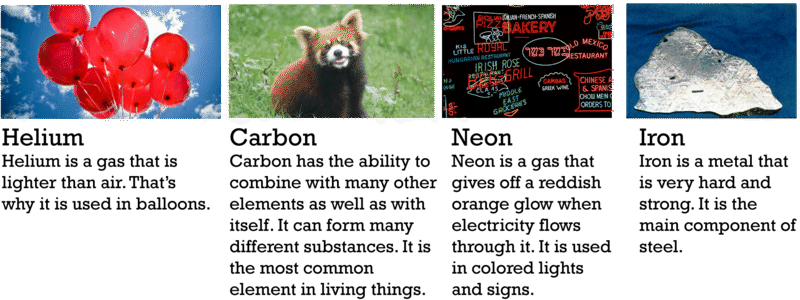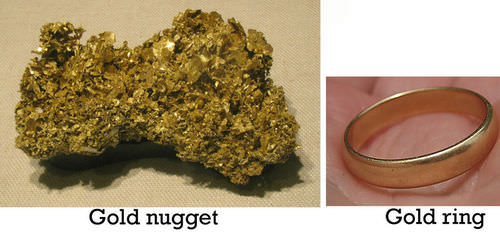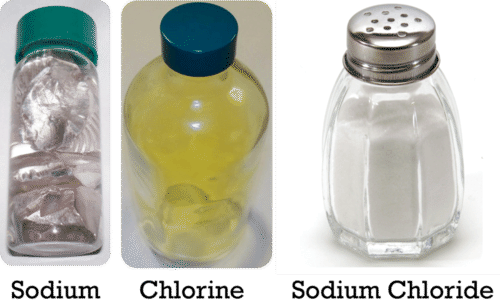1.2物质类型
章节大纲
-
Lesson Objectives
::经验教训目标- Describe elements and atoms.
::描述元素和原子。
- Describe compounds, molecules, and crystals.
::描述化合物、分子和晶体。
- Define mixture, and identify types of mixtures.
::界定混合物,并确定混合物的类型。
Lesson Vocabulary
::词汇表课程- atom
::原子原子
- colloid
::类类
- compound
::复合化合物
- crystal
::结晶晶体
- element
::元素元素
- mixture
::混合混合物
- molecule
::分子 分子
- solution
::解决方案
- suspension
::中止暂停
Introduction
::导言The properties of matter depend on the types of atoms that matter is made of. Matter can exist in two forms. It can be a pure substance. This means it is not mixed with anything. It can also be a combination of different substances. This means it can be a mix of different types of atoms. You may recall that atoms differ based on the numbers of protons they contain. Some atoms contain only one proton such as Hydrogen. Other atoms contain many protons. There are many types of atoms. For example, Helium has two protons. An Oxygen atom has eight. Water is composed of a two types of atoms. Water is made of two Hydrogen atoms and one Oxygen atoms. There are only so many types of atoms. These atoms can be mixed into an almost limitless amount of substances. So what do we call a substance that has only a single type of atom?
::物质特性取决于物质所制造的原子类型。 物质可以以两种形式存在。 物质可以存在。 物质可以是纯物质。 这意味着它不会与任何物质混合。 这也可以是不同物质的组合。 这意味着它可以是不同原子类型的混合体。 这表示它可以是不同类型原子的混合体。 你可能记得原子根据它们所含质子的数量而有所不同。 有些原子只包含一个质子, 如氢。 有些原子包含许多质子。 其他原子包含许多质子。 有多种原子。 例如, 赫利姆有两个质子。 一个氧原子有8个。 水由两种原子组成。 水由两种氢原子和一个氧原子组成。 只有许多种类的原子。 这些原子可以混合成几乎无限的物质。 因此, 我们称之为一种物质, 只有单一的原子类型吗?Elements
::要件要件要件An element is a pure substance. It contains only a single type of atom. Elements cannot be separated from one another. For example, water made up of hydrogen and oxygen. It can be broken apart into its elements.
::元素是一种纯物质, 它只包含单一的原子类型。 元素无法相互分离。 例如, 由氢和氧组成的水, 可以拆分成元素 。There are more than 90 different elements. Some are much more common than others. Hydrogen is the most common element in the universe. Oxygen is the most common element in Earth’s crust. Some elements are very rare. Gold and silver are very rare. Figure shows other examples of elements.
::有90多个不同元素。 有些比其他元素更常见。 氢是宇宙中最常见的元素。 氧是地球地壳中最常见的元素。 有些元素非常罕见。 金银非常罕见。 图显示了其他元素的例子。Each of the elements described here has different uses because of its properties. Properties of Elements
::元素属性Each element has a unique set of properties. It is this difference that makes them unique. As a result, elements can be identified by their properties. For example, the elements iron and nickel are both metals. Both are good conductors of heat and electricity. However, iron is attracted by a magnet. Nickel, another type of metal, is not. How could you use this property to separate iron from nickel?
::每个元素都有一套独特的属性。 正是这种差异使得它们具有独特性。 因此, 元素可以按其属性来识别。 例如, 元素铁和镍都是金属。 元素铁和镍都是好的热电导体。 但是, 铁是被磁铁吸引的。 另一种金属的镍不是。 您如何使用这些属性将铁与镍分离?History of Elements
::要件史The idea of elements is not new. It dates back about 2500 years. Aristotle was a famous Greek philosopher. He thought that all matter was made of just four elements. He identified the elements as earth, air, water, and fire. All matter would then be made of a mixture of these four elements.
::元素的概念并不是新概念,它可以追溯到大约2500年前。亚里士多德是希腊著名哲学家。他认为所有物质都由四个元素组成。他把元素确定为地球、空气、水和火。然后,所有元素都由这四个元素混合而成。Aristotle’s ideas about elements lasted for a very long time. In fact, they lasted for 2000 years. Then, scientists started to challenge his ideas. They started to find out about what we now call elements. Scientists discovered a total of 92 naturally occurring elements.
::亚里士多德关于元素的想法持续了很长一段时间。 事实上,它们持续了2000年。 接着,科学家开始质疑他的想法。 他们开始发现我们现在所谓的元素。 科学家发现了总共92个自然产生的元素。Elements and Atoms
::元素和原子An atom is the very smallest particle that still the element’s properties. All the atoms of an element are alike. They are also different from the atoms of all other elements. For example, atoms of gold are always the same. It does not matter if they are found in a gold nugget or a gold ring (see Figure ). All gold atoms have the same structure and properties. For example, all gold atoms contain 79 protons. One of gold's unique properties is that it is a great conductor of electricity. Gold is a better conductor of electricity than copper. Gold is more rare and expensive than copper. Copper is used in house wiring. Gold is far too expensive.
::原子是最小的粒子,它仍然是元素的特性。 元素的所有原子都是相似的。 它们也与所有其他元素的原子不同。 例如, 金的原子总是相同的。 如果在金金块或金环中发现, 并不重要( 见图 ) 。 所有金原子的结构和特性都是一样的。 例如, 所有金原子都包含79 质子。 金的特性之一是它是强大的电力导体。 金是比铜更好的电力导体。 金比铜更稀有、更贵。 金在房屋电线中使用铜。 金太贵了。Gold is gold no matter where it is found because all gold atoms are alike. Compounds
::化合物There are millions of different kinds of substances. This is due to the fact that elements can combine in many ways. These many unique ways they combine are what provide us with the vast array of substances. In fact, most elements are found in compounds. A compound is a unique substance that forms when two or more elements combine chemically. An example is water. Water forms when hydrogen and oxygen combine chemically. A compound always has the same components in the same proportions. It also has the same composition throughout. You can learn more about compounds and how they form by watching this video.
::有上百万种不同种类的物质。 这是因为元素可以多种方式的结合。 这些不同的组合方式 为我们提供了大量的物质。 事实上, 大部分元素都是在化合物中找到的。 化合物是一种独特的物质, 当两个或两个以上元素以化学方式结合时, 一种化合物是独特的物质。 一个例子是水; 水的形式, 当氢和氧以化学方式结合时, 水的形式。 化合物总是有相同的成分。 化合物也具有相同的成分。 您可以通过观看这个视频来了解更多的化合物和它们是如何形成的。Properties of Compounds
::化合物属性A compound has different properties than the substances it contains. For example, hydrogen and oxygen are gases at room temperature. When they combine, the two elements form water.
::例如,氢和氧是室温下的气体,当它们结合时,两种元素形成水。Pass the salt please! A chemist would call this compound sodium chloride. It contains sodium and chlorine. Sodium is a silvery solid that reacts explosively with water. Chlorine is a poisonous gas (see Figure ). Together, sodium and chlorine are harmless. It also tastes great when you sprinkle it on French Fries!
::请通过盐! 化学家会把这个化合物称为氯化钠。 它含有钠和氯。 钠是一种银状的固体, 与水有爆炸性反应。 氯是一种有毒气体( 见图 ) 。 钠和氯是无害的。 当洒在法国薯条上时, 钠和氯的味道也很好 。Table salt is much different from its components. What are some of its properties? Mixtures
::混合物Not everything you put together is a compound. Sometimes it is a mixture. A mixture is a combination of two or more substances. They can be in any proportion. This means the amount of each may vary. The substances in a mixture may be elements or compounds. So, what makes it a mixture and not a compound? When the substances combine, they do not form a new substance. Instead, they keep their original properties and just intermix. An example of a mixture might be sand and water. We can place them in the same container. Does anything change? The sand never becomes something else. Another well-known mixture is trail mix. Maybe you have some in your lunch bag.
::不是所有你加在一起的东西都是化合物。有时,它是一种混合物。混合物是两种或两种以上物质的组合,它们可以是任何比例的。这意味着每种物质的数量可能不同。一种混合物中的物质可能是元素或化合物。因此,是什么使它成为混合物而不是化合物?当物质组合时,它们没有形成新的物质。相反,它们保留了原有的特性,只是相交。一种混合物的例子可能是沙子和水。我们可以把它们放在同一个容器里。有什么变化吗?沙子永远不会变成别的东西。另一个已知的混合物是路径混合。也许你们在午餐袋里有一些。Homogeneous and Heterogeneous Mixtures (Advanced Topic)
::异同和异异异混合体(高级专题)Some mixtures are homogeneous. This means they have the same composition throughout. An example is salt water in the ocean. Ocean water is about 3.5 percent salt.
::有些混合物是同质的,这意味着它们在整个过程中的成分相同,例如海洋中的盐水,海洋水是3.5%的盐。Some mixtures are heterogeneous. This means they vary in how much of each is in the mixture. An example is trail mix. No two samples of trail mix will be exactly the same. One sample might have more raisins. Another might have more nuts.
::某些混合物是多种多样的。 这意味着这些混合物在混合物中每个混合物的含量不同。 例如, 路径混合。 没有两种路径混合的样本会完全相同。 一个样本可能有较多的葡萄干。 另一个样本可能有更多的坚果 。Particle Size in Mixtures (Advanced Topic)
::混合体中的粒子大小( 高级主题)Mixtures can have different properties. The property can depend on the size of their particles. Three types of mixtures based on particle size are described below. Figure shows examples of each type.
::混合体可具有不同的特性。属性可以取决于其颗粒的大小。下面介绍三种基于粒子大小的混合物。图显示了每一种类型的例子。- A solution is a homogeneous mixture with tiny particles. An example is salt water. The particles of a solution are too small to reflect light. As a result, you cannot see them. That’s why salt water looks the same as pure water. The particles of solutions are also too small to settle or be filtered out of the mixture.
::溶液是一种与微粒同质的混合物。 一个例子就是盐水。 溶液的粒子太小,无法反射光线。 结果,你看不到。 这就是为什么盐水看起来和纯水一样。 溶液的粒子也太小,不能固定或从混合物中过滤出来。
- A suspension is a heterogeneous mixture with large particles. An example is muddy water. The particles of a suspension are big enough to reflect light. This means you can see them. They are also big enough to settle or be filtered out. You may have seen items that say, "Shake Before Use." These items are usually a suspension. Salad dressings are a common suspension.
::悬浮是一个与大颗粒的混合体。 一个例子就是泥水。 悬浮的粒子足够大, 足以反映光线。 这意味着您可以看到它们。 它们也足够大, 可以固定或过滤出来。 您可能已经看到过“ 使用前的颤抖” 的物品。 这些物品通常是悬浮。 沙拉敷料是一种常见的悬浮。
- A colloid is a homogeneous mixture with medium-sized particles. Examples include homogenized milk and gelatin. The particles of a colloid are large enough to reflect light, so you can see them. But they are too small to settle or filter out of the mixture.
::类固醇是一种与中等大小颗粒的同质混合物,例如同质牛奶和凝胶。类固醇的粒子大到足以反映光线,所以你可以看到它们。但是它们太小,无法固定或过滤出混合物。
These three mixtures differ in the size of their particles. Which mixture has the largest particles? Which has the smallest particles? Separating Mixtures
::分离混合体Oh no! Your younger sister just mixed up all of your LEGO parts. Now you have to put them all back into the original categories. How can you do this? Of course, you sort them by size and shape. You can then place them back into their specific place in the tray. What do you think you could have called the mess your younger sister created? That's right, it is a mixture. Fortunately, it was a physical change and she just made a simple mixture. You are able to separate them back into order. It's a good thing she did not toss them into the fireplace. That would have caused a chemical change as they all melted together. If your LEGOs were melted, you would be out of luck for building that next big project.
::哦,不!你的妹妹刚刚把你们LEGO的所有部件都弄混了。现在,你必须把它们都放回原来的分类中。你怎么能这样做呢?当然,你可以用大小和形状来分拣它们,然后把它们放回托盘里的具体位置。你认为你妹妹制造的烂摊子叫什么来着?对,这是混合体。幸运的是,这是身体上的改变,她只是做了一个简单的混合体。你可以把它们分解出来。你也可以把它们分出来,这是一件好事,她没有把它们扔进壁炉里。这样就会在它们一起融化的时候造成化学变化。如果你们这些设备被熔化了,你就会失去运气来建造下一个大的工程。Mixtures keep their own identity when they combine. Therefore, they can usually be easily separated again. Their unique physical properties are used to separate them. For example, oil is less dense than water. Therefore, a mixture of oil and water can be separated by letting it stand. During this time the oil will float to the top. Other ways of separating mixtures are shown in Figure and in the videos below.
::混合体在组合时保持自己的特性。 因此, 它们通常很容易再次分离。 它们独特的物理特性被用来分离它们。 例如, 油的密度比水低。 因此, 油和水的混合体可以通过让其站立来分离。 在此期间, 油会浮到顶端。 其它分离混合物的方法在图中和下面的视频中显示 。Separating the components of a mixture depends on their physical properties. Which physical property is used in each example shown here? Lesson Summary
::经验教训摘要- Elements are pure substances with unique properties. There are more than 100 different elements (92 of which occur naturally). The smallest particles of elements are atoms.
::元素是具有独特特性的纯物质。有100多种元素(其中92种自然产生),最小元素颗粒是原子。
- Compounds are unique substances that form when two or more elements combine chemically. The smallest particles of compounds are molecules. Some compounds form crystals instead.
::化合物是两种或两种以上元素以化学方式结合时形成的独特物质。化合物中最小的粒子是分子。有些化合物则形成晶体。
Lesson Review Questions
::经验回顾问题Recall
::回顾- What is an element? Give three examples.
::什么是要素?请举三个例子。
- Describe compounds.
::描述化合物。
- What are mixtures?
::什么是混合物?
Apply Concepts
::应用概念- How could you use water and a coffee filter to separate a mixture of salt and sand?
::你们怎能用水和咖啡过滤器,把盐和沙子混合起来?
Think Critically
::仔细仔细思考- Create a concept map comparing and contrasting atoms, elements, compounds and mixtures. Include an example of each.
::创建比较和对比原子、元素、化合物和混合物的概念图。 包括每个原子、 元素、 化合物和混合物的示例 。
- How are atoms related to molecules?
::原子与分子的关系如何?
- Describe elements and atoms.




